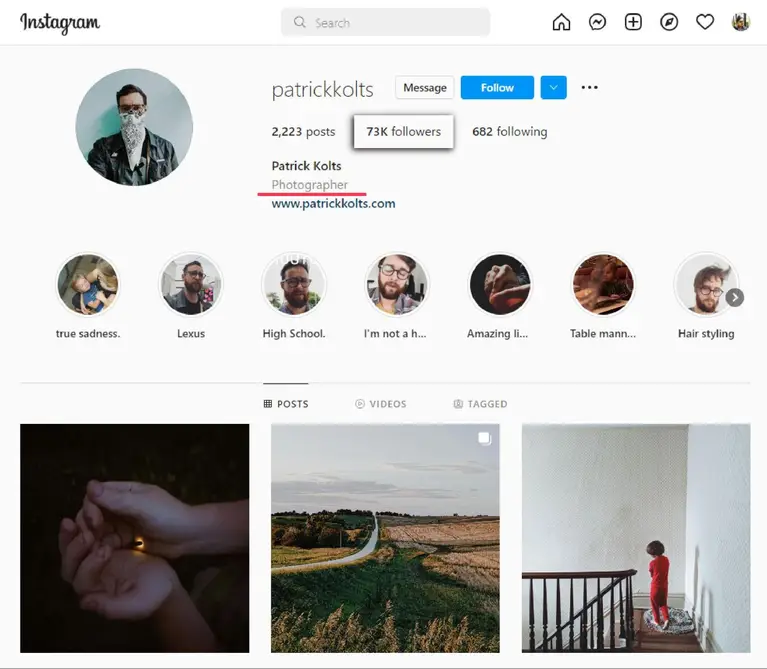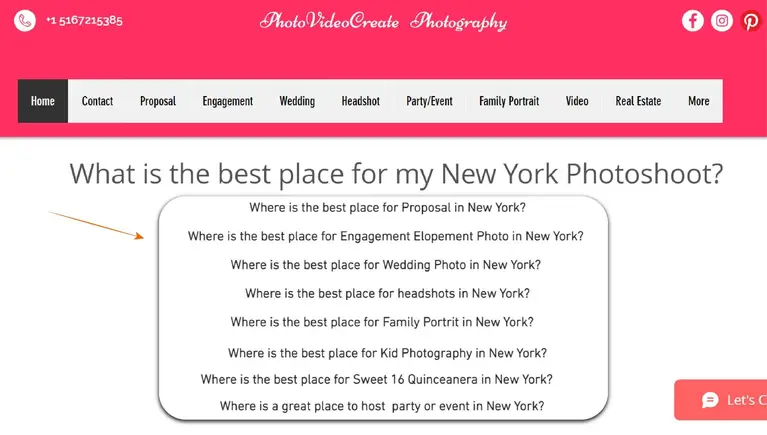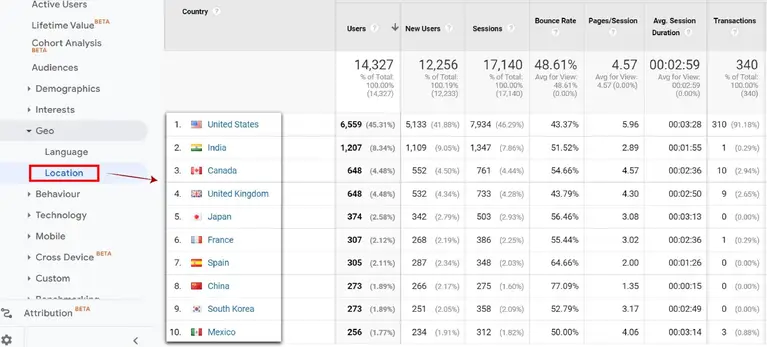
How to Fix 5 Common Local SEO Mistakes for Photographers
Intro
Whether a wedding or a birthday, the way a photographer captures moments has no parallel. And, with the advent of the internet, most searches for a photographer originate on Google.
Many photographers, however, miss out on local work as they are unaware of local SEO. This article is to help them plug their local SEO mistakes and enhance their revenue.
The Ten Key Local SEO Mistakes Photographers Need to Avoid
1. Ignoring Location in Your Key Phrase
Even your neighbor starts with an internet search before deciding on a photographer. So, make sure you mention your location on your website. Here’s how you can do that.
- On the ‘About’ page: If you specialize in destination photography, you can mention your location on ‘About.’
- Location in your keyphrase: ‘Wedding photographer in XXXX’ is a long-tail keyword with a built-in location. This means Google pulls results from the XXXX area, improving your chance of showing up on the first SERP.
- Add location in the footer: You can add location in the contact details of your website, as shown in the below screenshot.

This is another way of telling search engines to focus on a specific location.
2. Not having a Google Business Profile
A Google Business profile is a must-have if you have a studio and want local customers to visit it. For those who don’t know what it is, here’s a simple explanation:
A free tool to control a business listing on Google search environment (search, maps, and shopping).
If you have a listing, customers will find your studio when they search for photographers. You may appear in the venerable Google three-pack as shown in the image or as one of the studios listed further down.

If you still need reasons to list your studio on Google, here are three:
- A user will get all the critical information, including directions, from the listing.
- You will have some sort of control over the reviews customers post. If there’s a complaint, you can address it as well.
- A complete business profile with location details builds trust with potential customers.
Read: Step-by-step Setup Guide for Google My Business Set up
3. Playing Hard to Get
Having your NAP on most of your pages is as important as placing your location on the ‘About page.’ NAP is an acronym for ‘Name, Address, and Phone number. These three pieces of information are key to obtaining local customers. Here are three points you should keep in mind:
- Try to include a NAP on most of the web pages. Must be on the ‘About’ and ‘Home’ pages.
- Have a footer to add NAP without interfering with content on individual pages.
- Be consistent with your number on the website, social media, and other marketing channels.
Note: A consistent NAP will prevent getting indexed as separate businesses by Google. Ensure NAP accuracy using free or freemium tools like Brightlocal that provide details off all citations.

Also, try to have a local number. It lets you make a personal connection and gives the impression you are a local photographer.
4. Not Focusing on Local links
Google became the ‘king’ search engine because it curated results based on relevance. It did so through the simple mechanism of backlinks.
Though decades have passed since Google first used it, backlinks remain a key SEO signal.
Here are three ways you can get backlinks to your website:
- Link Up With Friends : Getting the ground running is tough. So, leverage your contacts and request your friends to link up with you in the same field.
- Start Guest Blogging : Keep your ego on the back burner and start guest blogging on relevant websites. The screenshot below shows how to use local keywords to find the sites that offer guest posts.
- Obtain Your Local Community’s Trust : Do this by organizing an exhibition or offering a free photography course.

Note: Make no truck with link mills. If search engines find your links are from such sites, they can penalize or completely ban you.
5. Failure to Leverage Reviews
Trust in User Generated Content (UGC) over advertisement is skyrocketing. Regardless of the quality of copies or photographs, UGC commands immense trust.
According to a 2016 study, 84 percent of users trust customer reviews online. Also, it is learned that Google might factor in UGC as a ranking signal.
How To Obtain Customer Reviews
1. Ask: Yes, most customers would leave a comment or rate you if you ask them properly. Send them a mail or a message a few days after the shoot.
2. Incentives: You can encourage customers to leave a review by offering something. You can run a monthly give-away campaign for the best review.
The below screenshot shows an example of how to approach customers to get a review.

3. Make it part of work: Ensure that your staff knows the value of obtaining customer reviews. You might also want to provide incentives to employees obtaining the most reviews.
Read: Reviews & Its Role in Local SEO
6. Not Having Social Media Accounts
Most photographers have a well-stacked website, a great way to showcase your work. Nonetheless, you must focus on social media so local contacts can see and comment on your works.
Social media platforms such as Instagram can bring many users to your work.
Such platforms help you connect with local and potential outstation customers in the form of followers, as shown below. It increases awareness, reaches, and thereby profits.

Tip 1: Always pin links to your social media accounts on your website. This is to help a hesitant customer further see your work and decide your suitability for the task.
Tip 2: Offer your newsletter if you happen to make it. This way, you also capture the potential customer's mail ID and use it for email marketing.
7. Poor Website Copy
They say a picture's worth a thousand words. But a single line of a well-written caption can augment the effect of a picture by a thousand times. However, not all photographers will have a flair for writing. You can, however, keep these three points in mind before sitting down to write.
- Don't use flowery adjectives.
- Keep it conversational
- Have someone proofread your copy
Tip: Try not to use cliched expressions such as 'We help you tell a story.
The below screenshot shows a site that has used all possible user queries or keywords to please the search engines rather than users.

Keep it simple and to the point. You can make up for what you lack in copywriting with your portfolio.
Why You Should Avoid Clichés
Suppose your website shows up in 4th or 5th position on a SERP. Your user might likely have already read copy on one or two websites. As such, they would not be in a mood to read any more cliched or cringe expressions.
8. Not Registering Your Website in Directories
Local directories are like the good old yellow pages. Those searching for services like photographers start their search from such directories.
The search engines also trust these directories as they rank them on top while suggesting business options to the users, as shown in the image below.

Having your name on local directories will help you:
- Boost your local SEO
- Get free backlinks
- Boost brand recognition
How to enlist in directories If you are starting, find your local photographers association. If there's none, join your local chamber of commerce website. That's a start; you can also enlist in Yelp, Foursquare, and bizjournals, among others.
Tip: Search " [your city] directories " if you want to find directories in your locality, search "[your city] directories". This will return your local service directories. And you can choose one suitable for photographers.
Read: Local Business Directories: Benefits & Tips to Use it Local Biz
9. Ignoring Metrics
Trying to improve your performance without metrics is like fishing in muddy waters. Metrics help you establish a baseline and allocate resources where they are due.
For example, you can find your traffic's specific location, time, and device through the Google Analytics tool, as shown below.

You can then optimize your website in a way you see fit.
Since any SEO strategy takes a long time to return results, it would be wise to take measurements from time to time. Here are the important local SEO metrics.
- Local Visibility - Local visibility tells where you stand on local search results. At any rate, you should try to rank high in searches from your town.
- Local Pack Search - This metric measure clicks on your link on Google's three-pack. Using this metric, you can determine how clicks on three-pack affect your organic ranking.
- New Sessions - New session is a metric that measures new users to your website. You can filter this metric further down based on regions or cities.
10. Website Not Optimized For Mobile Screens
Gone are the days when desk-top searches ruled the roost. Now, mobile devices make up more than half the worldwide searches. And those websites that don't have mobile optimization may not survive for long.
Thus, it’s vital to have mobile-friendly websites, as shown in the below image, that can showcase your photography skills to the audience.

Here's how screen-optimization helps SEO
- More Revenue: A screen-optimized website brings in more users. This is because they can access your site anytime and from anywhere.
- Higher User Experience: Websites optimized for different screens present information better. This helps improve the overall user experience.
- Ranking Factor: Search engines use screen optimization as a ranking signal.
Note: Screen optimization is important for businesses with a local customer base. Suppose a potential customer is in the vicinity of your business.
They are looking for a photographer. If your website is not screen optimized, the customer will unlikely choose your studio.
Key Takeaways
- Don't ignore location in your long-tail keywords.
- Create your Google Business profile or claim it if it exists
- Use your NAP consistently across the web
- Focus on local backlinks
- Obtain as much UGC as possible; incentivize it if needed
- Open social media accounts and handles
- Avoid cliched expressions on your website copy
- Enlist in your local directories
- Find key local SEO metrics and keep a tab on it
- Make your website mobile devices friendly
ABOUT THE AUTHOR:
Brice Decker

Brice has been handling marketing projects for more than 12 years and he is providing consulting services on SEO, Social Media and PPC. He has a huge expertise in working at large corporations including Accenture Interactive & PwC Digital Services.
ABOUT THE AUTHOR:
Brice Decker

Brice has been handling marketing projects for more than 12 years and he is providing consulting services on SEO, Social Media and PPC. He has a huge expertise in working at large corporations including Accenture Interactive & PwC Digital Services.
Related Post
How to Rebrand Your Business Without Losing SEO?